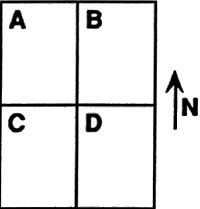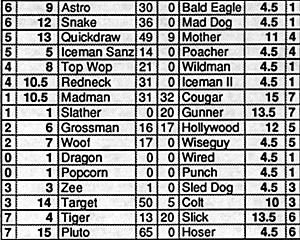 Background
Background
The Marines have landed at Inchon again and are in the thick of a fight to control the skies over the beachead. In just one of the many actions over the sand on D-Day, an element of Marine Hornets takes on the latest and greatest of the North Korean Air Force.
Game Length: 12 turns
1. Each aircraft initially has a radar contact with both aircraft on the opposing side. There are no lock-ons established and no aircraft have been spotted visually. All aircraft are air superiority gray.
2. Both American pilot have excellent fitness. The NKAF pilots are especially aggressive and suffer no initiative modifiers. The #1 MiG pilot is a Regular Combat Hero with no attributes. The #2 MiG pilot is a Regular with no attributes.
 3. The Hornets may use 6 turns of A/B power. The NfiGs may
use 7 turns of A/B fuel.
3. The Hornets may use 6 turns of A/B power. The NfiGs may
use 7 turns of A/B fuel.
4. Loads. F/A-18s: 1,9=AIM-9M, 2,8=AIN4-9L, 4,6--AIM120 5= 1200L FT, DDS=8F/8C. NEG-29s: 1,7=2 x AA-8B each, 2,6-- AA-10C, 3,5=AA-IOB, 4--1200L FT, DDS=8F/ 8C.
Results
 The new format for the scores here may require some
explanation. The center columns are scenario points as before. The
bold match point scores adjacent to each pilot's call sign are their
match points for the round. In addition, in order to spur cooperative
flying, match points were awarded to each team based on their total
scenario points as compared to other teams on the same side.
The new format for the scores here may require some
explanation. The center columns are scenario points as before. The
bold match point scores adjacent to each pilot's call sign are their
match points for the round. In addition, in order to spur cooperative
flying, match points were awarded to each team based on their total
scenario points as compared to other teams on the same side.
Thus Tiger and Pluto with their incredible 78 point total outscored all other Hornet teams and received 7 additional match points. This did seem to work well and players flew as a team at most tables, even though they still were out to get kills on their own-- sounds pretty much like any real pilot story I've ever read.
I wasn't playing in this round since some dropouts had left us with an even number of tables. I did get a chance to watch a little more action as a consequence and some of the play was most entertaining. Table Three (Top Wop, Redneck, Wildman, Iceman II) saw some of the most intriguing events I've seen performed by players in Air Superiority.
Top Wop came over to the scoring table early in the round to ask about he legality of a move. He wanted to fire an AIM-120 out of parameters at the opposition just to get them to engage. I realize that there are no provisions for such an act in the standard Air Superiority rules, but I figured that at the level of a National Tournament, the players should be able to handle such excursions. In addition, the tactics of firing an unguided missile to force opponents to maneuver is a tried and turn one--even to the point where the Air Force was once considering the acquisition of "Smokey Sparrows": unguided rockets to be fired from extreme visual range in the hopes of getting an opponent to react to the sight of a missile launch. Fortunately pilots prevailed insisting that it would be stupid to waste a weapon station on a decoy when you could hang a real missile there instead.
The ploy worked, causing Wildman to declare himself engaged long enough to lose the initiative and discover that the missile wasn't tracking. But Wildman returned the favor. He received an "H"hit later from Top Wop and the roll on the damage table shut down his weapons systems. Of course, other pilots didn't know that. Wildman continued to fly in a threatening fashion until he progressed to "C" damage and was forced to eject. An interesting fight that was well-flown on both sides, even though the MiGs were unable to score any points.
Table Five also saw some interesting action. Here the scenario pitted four really fine players, all with previous ORIGINS experience, in what some spectators saw as the premiere event of the day. The combatants were Grossman (Bob Gross), Woof (Roger Taylor), Hollywood (Karl Meuller). and Wiseguy (Paul Procyk). You can bet they recognized each other as wen.
When I announced the players, they all approached the table with looks of genuine concern--this one was going to be tough. Unfortunately for Paul (and Karl), he took an AIM-120 in the face from Grossman just before the merge, and that pretty much sealed the fate for the MiG team. Karl did an outstanding job in the ensuing 1 v 2, managing to avenge his wingman by killing Grossman before getting an AIM-9 shot from Woof that put him away. I'm actually sorry it didn't get a chance to get into the furball since I think that would have been an interesting and very close contest. Paul wasn't happy about it either, and Paul has expressed strong opinions about long-range radar missile duels.
Of course, the starting positions for this scenario were chosen to allow one good radar missile exchange before getting into the serious dogfight and I expected that sometimes this would lead to an early kill for someone. Because of the match point scoring, I didn't think this would be a problem. I was surprised, though, to see how many of the MiG pilots failed to score. The AMRAAM is an impressive weapon and the Hornet is a fine aircraft. Apparently these two factors conspired to stack the deck prominently in favor of the American side. Hornet drivers outscored the MiG pilots 374 to 103 in scenario points.
Most interesting to me is the score racked up by our fearless leader, Pluto. His section leader, Tiger, managed to get in a solid hit before getting killed by Slick, but in the true wingman form, J.D. proceeded to destroy both opponents---and took his time doing it. In repeatedly damaging Hoser before finally shooting him down, Pluto scored an unprecedented 65 scenario points and an easy top score.
One of my playtesters from Huntsville, Target (Fred Gray), put in a very good showing against Sled Dog and Colt, scoring 50 scenario points to take second place in match points. He was not happy to see J.D.'s score, either, since he was certain he had gotten a top. These things happen, eh Fred?
But now it came time to separate the men from the boys. I quickly compiled the scores from the first three rounds to set up pairings for the final 4 v 4 engagement. I decided that it would give the weaker players a chance (and help make for an exciting scenario) if the players were distributed such that the top eight players were at Table One, the next eight at Table Two, and so on. To make sure the sides were balanced, the 1st, 3rd, 5th, and 7th best scores were assigned to play one side, while the 2nd, 4th, 6th, and 8th best scores were given the opposing side. The scenario was one intended to produce immediate fireworks.
Back to Table of Contents -- Air Power # 15
Back to Air Power List of Issues
Back to MagWeb Magazine List
© Copyright 1991 by J.D. Webster
This article appears in MagWeb.com (Magazine Web) on the Internet World Wide Web.
Other articles from military history and related magazines are available at http://www.magweb.com